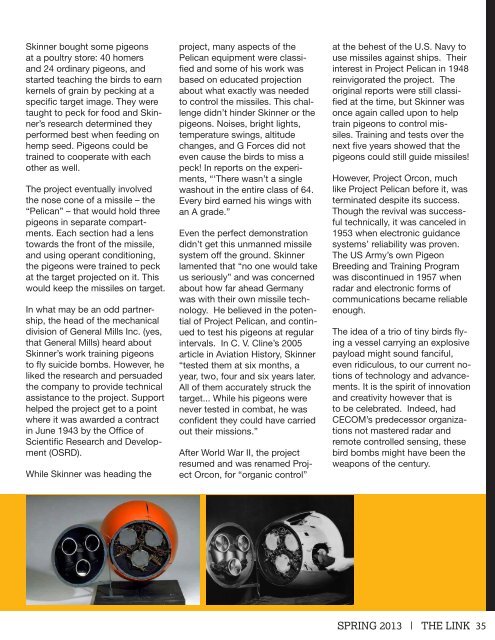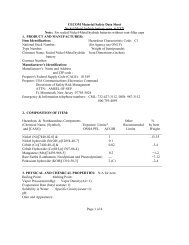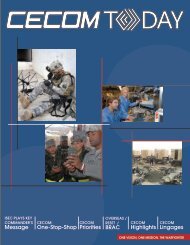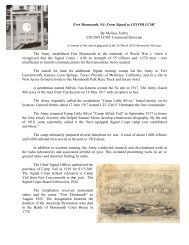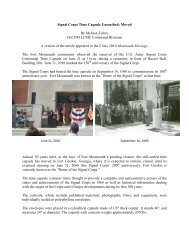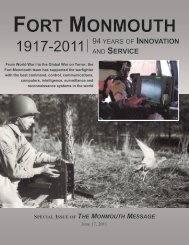download PDF version - CECOM - U.S. Army
download PDF version - CECOM - U.S. Army
download PDF version - CECOM - U.S. Army
Create successful ePaper yourself
Turn your PDF publications into a flip-book with our unique Google optimized e-Paper software.
Skinner bought some pigeons<br />
at a poultry store: 40 homers<br />
and 24 ordinary pigeons, and<br />
started teaching the birds to earn<br />
kernels of grain by pecking at a<br />
specific target image. They were<br />
taught to peck for food and Skinner’s<br />
research determined they<br />
performed best when feeding on<br />
hemp seed. Pigeons could be<br />
trained to cooperate with each<br />
other as well.<br />
The project eventually involved<br />
the nose cone of a missile – the<br />
“Pelican” – that would hold three<br />
pigeons in separate compartments.<br />
Each section had a lens<br />
towards the front of the missile,<br />
and using operant conditioning,<br />
the pigeons were trained to peck<br />
at the target projected on it. This<br />
would keep the missiles on target.<br />
In what may be an odd partnership,<br />
the head of the mechanical<br />
division of General Mills Inc. (yes,<br />
that General Mills) heard about<br />
Skinner’s work training pigeons<br />
to fly suicide bombs. However, he<br />
liked the research and persuaded<br />
the company to provide technical<br />
assistance to the project. Support<br />
helped the project get to a point<br />
where it was awarded a contract<br />
in June 1943 by the Office of<br />
Scientific Research and Development<br />
(OSRD).<br />
While Skinner was heading the<br />
project, many aspects of the<br />
Pelican equipment were classified<br />
and some of his work was<br />
based on educated projection<br />
about what exactly was needed<br />
to control the missiles. This challenge<br />
didn’t hinder Skinner or the<br />
pigeons. Noises, bright lights,<br />
temperature swings, altitude<br />
changes, and G Forces did not<br />
even cause the birds to miss a<br />
peck! In reports on the experiments,<br />
“‘There wasn’t a single<br />
washout in the entire class of 64.<br />
Every bird earned his wings with<br />
an A grade.”<br />
Even the perfect demonstration<br />
didn’t get this unmanned missile<br />
system off the ground. Skinner<br />
lamented that “no one would take<br />
us seriously” and was concerned<br />
about how far ahead Germany<br />
was with their own missile technology.<br />
He believed in the potential<br />
of Project Pelican, and continued<br />
to test his pigeons at regular<br />
intervals. In C. V. Cline’s 2005<br />
article in Aviation History, Skinner<br />
“tested them at six months, a<br />
year, two, four and six years later.<br />
All of them accurately struck the<br />
target... While his pigeons were<br />
never tested in combat, he was<br />
confident they could have carried<br />
out their missions.”<br />
After World War II, the project<br />
resumed and was renamed Project<br />
Orcon, for “organic control”<br />
at the behest of the U.S. Navy to<br />
use missiles against ships. Their<br />
interest in Project Pelican in 1948<br />
reinvigorated the project. The<br />
original reports were still classified<br />
at the time, but Skinner was<br />
once again called upon to help<br />
train pigeons to control missiles.<br />
Training and tests over the<br />
next five years showed that the<br />
pigeons could still guide missiles!<br />
However, Project Orcon, much<br />
like Project Pelican before it, was<br />
terminated despite its success.<br />
Though the revival was successful<br />
technically, it was canceled in<br />
1953 when electronic guidance<br />
systems’ reliability was proven.<br />
The US <strong>Army</strong>’s own Pigeon<br />
Breeding and Training Program<br />
was discontinued in 1957 when<br />
radar and electronic forms of<br />
communications became reliable<br />
enough.<br />
The idea of a trio of tiny birds flying<br />
a vessel carrying an explosive<br />
payload might sound fanciful,<br />
even ridiculous, to our current notions<br />
of technology and advancements.<br />
It is the spirit of innovation<br />
and creativity however that is<br />
to be celebrated. Indeed, had<br />
<strong>CECOM</strong>’s predecessor organizations<br />
not mastered radar and<br />
remote controlled sensing, these<br />
bird bombs might have been the<br />
weapons of the century.<br />
SPRING 2013 | THE LINK 35


